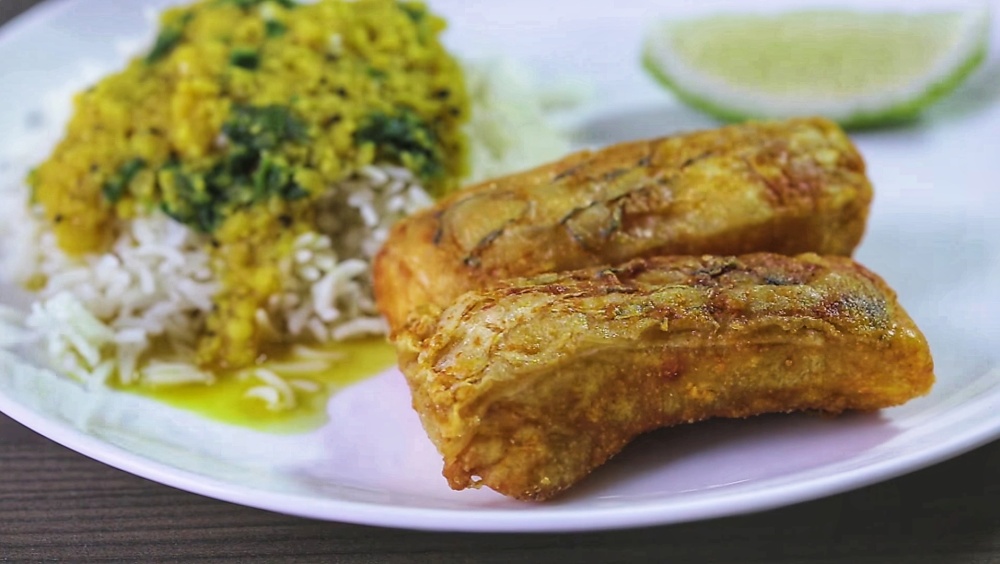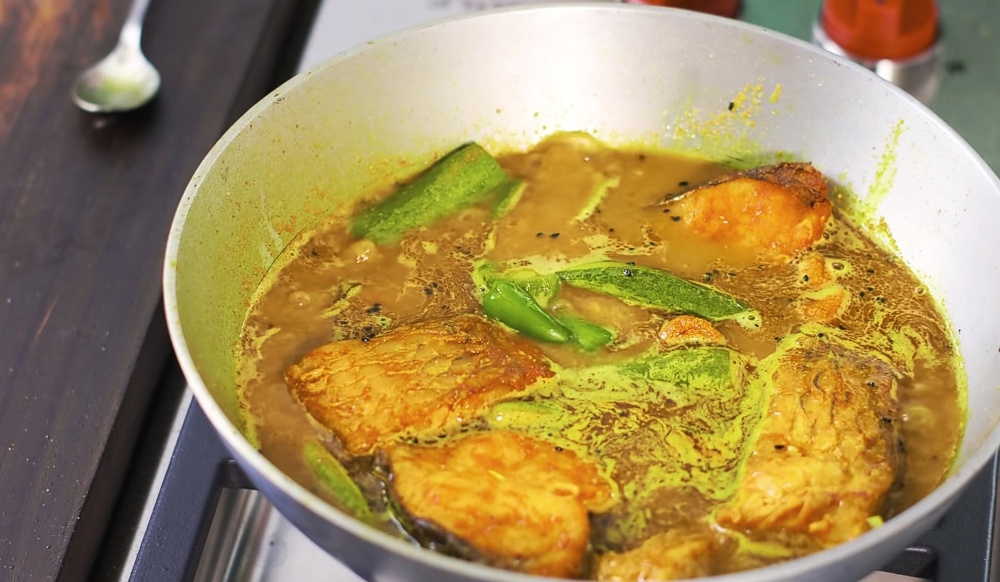In Part 1 of this series, we began our journey with a visit to the fish market and an overview of the major cuts of fish. It’s time to get cooking, and what better to start with than the simplest fish dish possible? The recipe couldn’t be simpler: coat pieces of fish in salt and turmeric, the go-to spice duo when it comes to fish dishes. Fry them in oil till they’re brown and crisp on the outside and cooked all the way through. And voila! You’ve made machh bhaja.
Machh bhaja with rice and dal is the epitome of Bengali comfort food. Rui and katla are perennial classics. The large bones in a katla machh er peti makes it a popular choice among kids. Tiny mourola fish incredibly affordable and are excellent fried as is, or even although you could use them to make a dry, spicy chorchori or a tangy ombol with raw mangoes in the peak of summer. (More on ombols in our Taste of Bengal article).

Of course, fried fish can get slightly more complex. The pomfret fry is popular elsewhere in India as well and uses a more elaborate spice paste to marinate the fish before frying, although you could go with the simple salt-turmeric duo as well. Tiny topshe fish are coated in spices and flour and fried like fritters, excellent as a snack or as an accompaniment to khichuri.
Which brings us to the undisputable king of fish. While the katla bhaja is relatively easy to eat, the prized ilish bhaja is laden with multiple tiny bones which can deter the beginner, but is second nature to an expert. And why bother eating such a fish? Because it is delicious! Like salmon, ilish is a fatty fish, and the fat renders out into the oil it is fried in. Mustard oil with rendered ilish fat is liquid gold, and I could finish off an entire plate of rice with just fried ilish and spoonfuls of ilish oil. Complexity in minimalism at its very best.

And while we’re frying stuff, mention must be made of machh er dim er bora (or if you want to be obnoxious about it, fish roe fritters). Popular choices include rui and ilish. While rui machh er dim is usually made into a fritter using spices and chickpea flour, the coveted ilish machher dim, still inside the fish, is simply fried along with the fish itself and eaten as is. Dimwala ilish machh er peti is nothing short of perfection (more on fish roe here)
Compared to Westerners, Bengalis are much less squeamish about dainty mise en place, and are admirably adept at picking out the tiniest bones from a piece of ilish. It takes time, but that simply means you get to savour it for longer. On the contrary, the go-to cut of fish in the West is the fillet, cut alongside the spine, along the length of the body of the fish. After filleting, the pieces of fish painstakingly pin-boned to yield boneless pieces of fish. The fish fillet forms the basis of two Calcutta classics: the fish fry and the fish kobiraji, staples of the café and cabin culture of North Calcutta. But, since we are sticking to a more traditional theme right now, we’ll come back to this in a while.

If you wrap the fish in a parcel and then cook it in a pan, you get a bit of char on the outside, the fish ends up cooking predominantly by steaming, en papillote style. And the classic example of this is the paturi. The paturi is a style of fish cooking which involves wrapping marinated pieces of fish in banana leaves and placing them in a skillet or oven. The banana leaves dry and char at places, but the fish cooks primarily by steaming in its own moisture. The traditional flavouring is mustard paste, but you could bring your own variations, like the gondhoraj lime, aam kasundi or poppy seed paste.
Mustard is a classic pairing with fish and is used widely in fish dishes. Mustard oil is a must when it comes to machh bhaja; its sharp pungency lends the fish a unique flavour which you simply won’t get with vegetable oil. Kumro patay ilish is another variation of the paturi, using the prized ilish fish seasoned with punchy mustard oil and other ingredients, and Nola has an excellent recipe for it, paired with its usual brand of nostalgic anecdotes and perfectly ambient music. Check out the link at the end of the article.

The texture of steamed fish is very different from fried, and the same technique can be used for a variety of fish, beyond bhetki and ilish. Of course, there are simpler ways of steaming, one of them employing a steel container or tiffin kouto to steam fish like ilish or chingri. And speaking of chingri, mention has to be made of the old-school kochu pata diye chingri bhapa, made by steaming prawns and cooked taro leaves in a mustard-coconut-poppy paste, a delicate mélange of flavours that is hard to describe in words.
Delicate fish paired with punchy mustard, be it in the form of mustard oil or mustard paste or both, is yin and yang at its very best. This contrast is also employed in the Bengali cabin food, with the quintessential mustard condiment called kasundi accented with the tang of raw mango, the condiment of choice with fish fry and kobiraji (keep that ketchup aside, I say) And of course, mustard paste forms the basis for paturi and numerous fish curries, notably pabda, parshe and pomfret which are served whole, along with our familiar ilish and bhetki. Before dealing with complex curries though, it is necessary to take a step back and start with a simple fish curry template.

Like the machh bhaja, the fish is rubbed with salt and turmeric and fried lightly. Bengalis have a tendency to overcook everything, which is why dunking fresh pieces of fish into a simmering jhol is uncommon. However, care should be taken not to fry the fish too much, as it will cook further in the broth. To make the jhol or broth, mustard oil is added and tempered with whole spices, followed by the add-ons and spices. When that’s cooked, enough water is added to make a light broth. Finally, the fried fish is added and the curry is slowly simmered till done.
However, fish curries can get a lot more complex. Next time, we will explore the entire spectrum of fish curries, from the simple jhol to the decadent kaalia, before winding up our series via an overarching view of the machh spectrum in the context of the Bengali meal.
One Comment Add yours